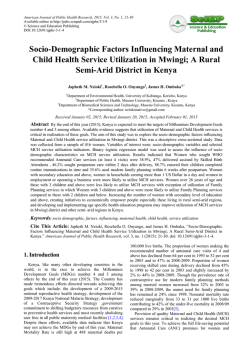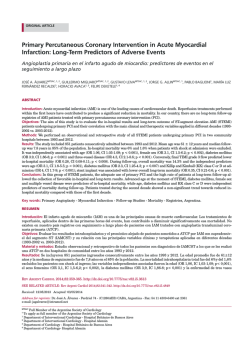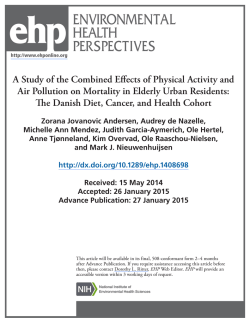
View PDF version of the article
Article ID: WMC004821 ISSN 2046-1690 Atypical Placement Abruption: Clinical suspicion and management Peer review status: No Corresponding Author: Dr. A. Isabel M Fernandez, Ana Isabel M.Fernandez, Obtetrics & Gynecology Laredo, 39009 - Spain Submitting Author: Dr. A. Isabel M Fernandez, Ana Isabel M.Fernandez, Obtetrics & Gynecology Laredo, 39009 - Spain Article ID: WMC004821 Article Type: Case Report Submitted on:28-Jan-2015, 11:15:58 PM GMT Published on: 29-Jan-2015, 12:27:41 PM GMT Article URL: http://www.webmedcentral.com/article_view/4821 Subject Categories:OBSTETRICS AND GYNAECOLOGY Keywords:Placental, abruption, morbidity, pregnancy, metrorrhagia How to cite the article:Fernandez AM. Atypical Placement Abruption: Clinical suspicion and management. WebmedCentral OBSTETRICS AND GYNAECOLOGY 2015;6(1):WMC004821 Copyright: This is an open-access article distributed under the terms of the Creative Commons Attribution License(CC-BY), which permits unrestricted use, distribution, and reproduction in any medium, provided the original author and source are credited. Source(s) of Funding: No funding details. No compensation or any economic funding was received by the authors. Competing Interests: Author has not any relevant financial relationships to disclosure in relationship to this article. Nothing to disclose. WebmedCentral > Case Report Page 1 of 4 WMC004821 Downloaded from http://www.webmedcentral.com on 29-Jan-2015, 12:27:42 PM Atypical Placement Abruption: Clinical suspicion and management Author(s): Fernandez AM Abstract PA is a serious obstetric complication; it is responsible for an important maternal and perinatal morbidity and mortality. Its risk factors have been identified but it is often unpredictable. The classic clinical triad is present in only a few cases. Suitable obstetric management is the key to avoid maternal and perinatal unwished outcomes. It is reported a case of a pregnant woman, without risk factors except for multiparity, who submitted a PA with incomplete triad of symptoms and its decisive management. Introduction Placental abruption (PA) is a serious multifactorial obstetric complication; it occurs in 0.4-1% of pregnancies, although its real frequency is difficult to estimate, because it varies depending on the population studied and diagnostic factors selected. (1,2) PA refers to bleeding at the decidual-placental interface that causes partial or total placental detachment prior to delivery of the fetus. PA gives rise to considerable maternal and perinatal morbidity and mortality (clotting disorders, hemorrhagic shock and rarely death, are the most common maternal complications) but also rises fetal complications; the principal cause is prematurity, with its associated morbidity, but also intrauterine growth restriction and intrauterine fetal death (2,6). Neonatal morbidity and mortality rates have fallen over the past few decades because of improvements in obstetrical management, the liberal use of cesarean delivery and improved neonatal care; in fact, perinatal mortality has decreased from 20% in the 1970s to 9-12% currently. (3,7) Several risk factors for PA have been identified: smoking, chronic hypertension, preeclampsia, pregnancy induced hypertension, a maternal age above 35 years, multiparity, PROM, polyhydramnios, previous PA, in vitro fertilization, addictive behavior (alcohol, cocaine), male-sex fetuses… ( 2 , 5 , 8 ) Identification of these factors is a critical issue; appropriate monitoring and prevention measures to be offered to that at-risk population. The presence of some of them may help to make the diagnosis of PA. At first, diagnosis is clinical, based on the classic triad of metrorrhagia in the second and third trimester associated with abdominal pain and uterine hypertonia; a non-reassuring fetal status is often associated. However, PA occurrence is often unpredictable and asymptomatically; metrorrhagia, pain or hypertonia are not specific for PA, so diagnosis is then made by the discovery of fresh or longstanding clots on placental examination, during hysterotomy. It has been described the classic form was found in only one-third of cases (10). Ultrasonography, which is not carried out systematically, has an excellent specificity (92-96%) but its sensitivity is low (24%) (2, 11, 12), so it can be useful when diagnostic is uncertain but only if it does not delay the patient’s management. Moreover, histological confirmation is not constant, especially when PA occurs suddenly because detachment has been so recent and sudden that clots have not had time to form (9, 14). The lack of sensitivity of pathological examinations underlies the importance of clinical examination for PA diagnosis. Fetal vitality and maternal condition guide obstetric management of PA (2) . If the fetus is living, and emergence caesarean should be performed unless vaginal delivery is imminent (caesarean section rates between 74-94%) (7,13) and in case of fetal bradycardia, extraction by caesarean within 20 min significantly reduces neonatal mortality and the incidence of cerebral palsy. In case of intrauterine fetal death, vaginal delivery is possible with close clinical and laboratory monitoring. In developed countries, maternal mortality has become rare but there is still significant morbidity linked to the hemorrhagic risk due to hematoma formation, which is readily associated with disseminated intravascular coagulation. In these cases, an early management should be performed, including an intensive care team. Neonatal mortality in PA is mainly associated with prematurity. Although up to 26 or 32 weeks, there is no mortality difference whether PA is present or not, after 26-32 weeks, PA is a risk factor for neonatal mortality independent of the gestational age. (2) Case Report A 32-year Caucasian woman, gravid 3 para 2, was WebmedCentral > Case Report Page 2 of 4 WMC004821 Downloaded from http://www.webmedcentral.com on 29-Jan-2015, 12:27:42 PM admitted at gestational age of 37 weeks, due to sudden labor pains which started one hour prior to her admission; there was no history of bleeding per vagina. Fetal movements decreased in the last hours. She had previously normal pregnancies and vaginal births. In the current pregnancy there were no complications and baby’s scans were reported to be normal. On examination: she was not pale, pulse 89/minute, maternal blood pressure was 142/88 mmHg, temperature 36.8ºC, bilateral edema of lower limbs but she denied headache, flickering in front of eyes or epigastric pain. Uterus was tender and woody hard with palpable contractions. Its size corresponded to the period of gestation. It was difficult to hear the fetal heart by Sonicaide. An ultrasound scan was performed; it revealed a bradycardic fetus in cephalic presentation; the placenta was located in the fundus and in the left anterolateral wall and a doubtful hypoechogenic image (85 x 55 mm) suggested the presence of a deciduate placental hematoma. On speculum examination: there was no bleeding, no leaking of liquor, cervix was 2 cm dilated with membranes intact. Laboratory test results were hemoglobin 12,3 g/dL, hematocrit 31.1 %, platelets 175 x 109 /mm3 and parameters of coagulation were normal. She was catheterized, cross matched and given intravenous fluid; in view of the above findings, abruption of placenta was suspected. An emergent uncomplicated caesarean section under general anesthesia was performed and a female infant weighing 2730 g was delivered. The ultrasound suspicion of PA was confirmed intraoperatively. The fetal APGAR score was 7 and 9 at the 1st and 5th minute, respectively and any kind of resuscitation was necessary. Cord blood pH was 7.26 in the artery. The postoperative course was uneventful without coagulation disorders or transfusion. There was a drop in hemogolobin from 12.3 to 9.8 g/dL. She was discharged home with her baby on the 5th postoperative day. The only medication she received on discharge was iron supplementation. Her postnatal obstetric and medical appointments revealed no obvious pathology. Histologial examination confirmed the diagnosis (placental infarctions and decidual vasculopathies). Discussion PA is serious case of maternal morbidity and fetal morbidity and mortality. Risk factors that cause PA include hypertension and preeclampsia, smoking, WebmedCentral > Case Report trauma to the abdomen, gestational diabetes mellitus, preterm labor, age older than 40 years… In this case, no risk factors had been identified in the present pregnancy except for multiparity. The timely attendance to the hospital and timely admission with suspicion of abrution allowed us to intervene very early and quickly, thereby preventing and adverse outcome. In our case, there was no external bleeding and no maternal compromise; the only symptom was abdominal pain and the only clinical sign was a tense and tender abdomen. Conclusion The risk factors for PA are clearly identified, but its occurrence often remains unpredictable and the classic clinical triad is rarely observed. Ultrasonography has a limited value to diagnostic PA. It is very important to educate patients and clinicians about symptons of abruption. Obstetric management is guided by fetal and maternal condition, so a multidisciplinary management (obstetrician, anesthesiologist, pediatrician, nurses…) can limit maternal morbidity and mortality, although perinatal mortality, which occurs essentially in utero, remains high. References 1. Tikkanen M.: Etiology, clinical manifestations, and prediction of placental abruption. Acta Obstet Gynecol Scand 2010; 89: pp. 732-740 2. Oyelese Y., and Ananth C.V.: Placental Abruption. Obstet Gynecol 2006; 108: pp. 1005-1016 3. Ananth C.V., and Wilcox A.J.: Placental abruption and perinatal mortality in the United States. Am J Epidemiol 2001; 153: pp. 332-337 4. Kåregård M., and Gennser G.: Incidence and recurrence rate of abruptio placentae in Sweden. Obstet Gynecol 1986; 67: pp. 523-528 5. Tikkanen M., Riihimäki O., Gissler M., et al: Decreasing incidence of placental abruption in Finland during 1980–2005. Acta Obstet Gynecol Scand 2012; 91: pp. 1046-1052 6. Ananth C.V., Berkowitz G.S., Savitz D.A., and Lapinski R.H.: Placental abruption and adverse perinatal outcomes. JAMA 1999; 282: pp. 1646-1651 7. Tikkanen M., Luukkaala T., Gissler M., et al: Decreasing perinatal mortality in placental abruption. Acta Obstet Gynecol Scand 2013; 92: pp. 298-305 Page 3 of 4 WMC004821 Downloaded from http://www.webmedcentral.com on 29-Jan-2015, 12:27:42 PM 8. Tikkanen M.: Placental abruption: epidemiology, risk factors and consequences. Acta Obstet Gynecol Scand 2011; 90: pp. 140-149 9. Elsasser D.A., Ananth C.V., Prasad V., and Vintzileos A.M.: Diagnosis of placental abruption: relationship between clinical and histopathological findings. Eur J Obstet Gynecol Reprod Biol 2010; 148: pp. 125-130 10. Hurd W.W., Miodovnik M., Hertzberg V., and Lavin J.P.: Selective management of abruptio placentae: a prospective study. Obstet Gynecol 1983; 61: pp. 467-473 11. Glantz C., and Purnell L.: Clinical utility of sonography in the diagnosis and treatment of placental abruption. J Ultrasound Med 2002; 21: pp. 837-840 12. Kikutani M., Ishihara K., and Araki T.: Value of ultrasonography in the diagnosis of placental abruption. J Nippon Med Sch 2003; 70: pp. 227-233 13. Kayani S.I., Walkinshaw S.A., and Preston C.: Pregnancy outcome in severe placental abruption. BJOG 2003; 110: pp. 679-683 14. Elsasser D.A., Ananth C.V., Prasad V., and Vintzileos A.M.: Diagnosis of placental abruption: relationship between clinical and histopathological findings. Eur J Obstet Gynecol Reprod Biol 2010; 148: pp. 125-130 WebmedCentral > Case Report Page 4 of 4
© Copyright 2025








